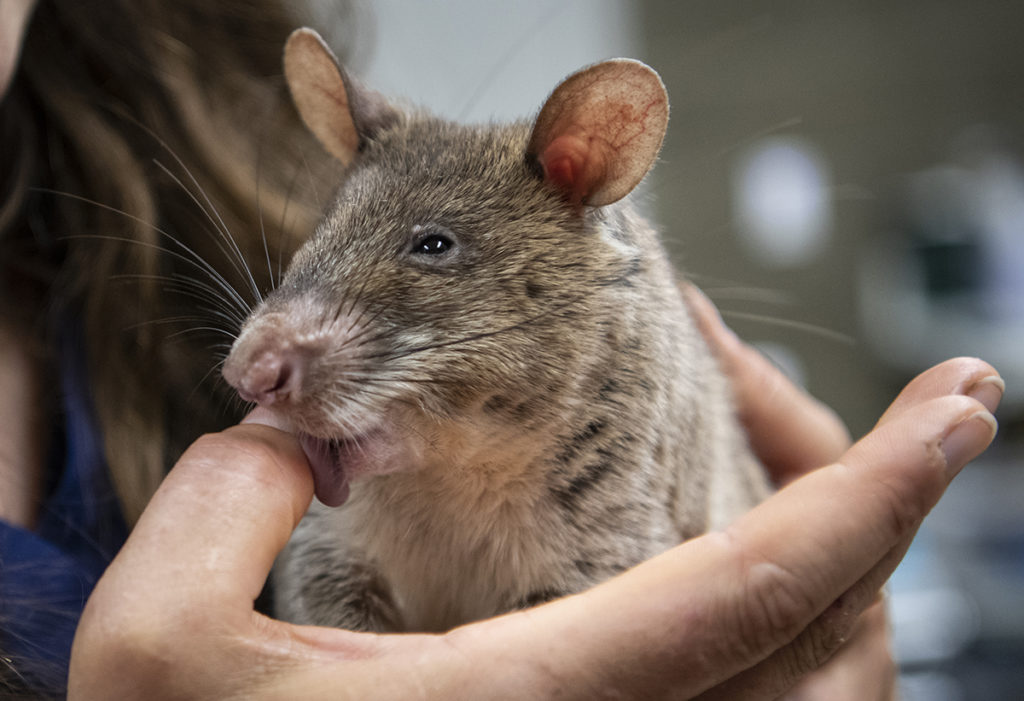There are a lot of moving parts to being a zookeeper in the Wild Wonders Outdoor Theater at Point Defiance Zoo & Aquarium – but training ambassador animals is a big one, says keeper Jessie.
7:30am
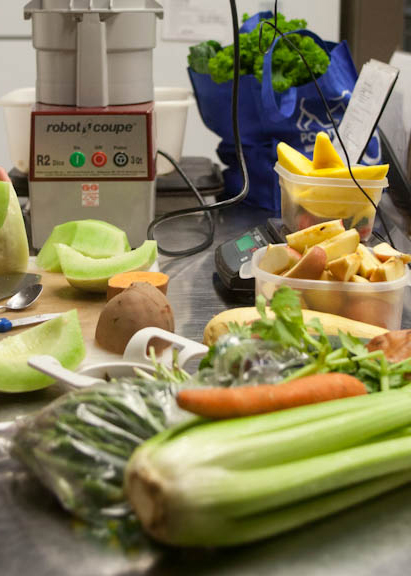
A zookeeper’s day often begins with checking on animals, cleaning habitats and giving breakfast. The big difference at Wild Wonders is just how many different animals there are: around 38 different species, from macaw to millipede and tarantula to tamandua. Jessie’s part of a team, and as they go from habitat to habitat behind the scenes, they feed dozens of different diets, check on feathers and fur, and even monitor poop for signs of health.
Then there’s making all those diets.
“If I’m prepping diets, I get here at 6am,” says Jessie. “There’s a lot of chopping and measuring fruit and veggies. I’m not a great cook but I’m excellent at chopping!”
10am
After break, Jessie (or another team member) sets about chores: everything from cleaning the office and food prep kitchen to gathering leafy browse from the Zoo’s gardens. She’ll make enrichments for animals, like puzzle feeders for Herald, the Zoo’s domestic dog.
But it’s training that keeps her – and the animals she cares for – on their toes. Keepers around the Zoo train many different types of behaviors: natural ones like digging or climbing, done for enrichment or exercise; and those that let them take part in their own care, like offering a paw for a voluntary blood sample or vaccination. Training helps keepers build a trusting bond with animals, and lets animals make choices and cooperate in their own care.
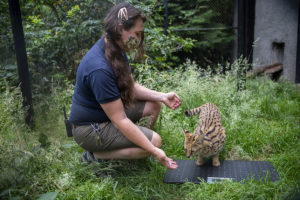
Today, Jessie starts with something easy. Picking up a bag of treats and a big flat scale, she slips quietly into the outdoor yard to find Sheldon. He’s a serval – an African wildcat a little smaller than a lynx, with a lush spotted coat. Sheldon’s eight years old and a regular on the Wild Wonders stage. Although he’s a wild animal, he knows this behavior very well. Slinking up to Jessie, he stands on the scale and looks up expectantly. Jessie laughs and gives him a rare treat – a dab of whipped cream. As he licks, she takes the reading: 7.35 kg (about 17lbs). Then she gives him a careful rub between his ears.
“He does like a pat, but on his terms,” she explains. “Being a wild animal, his mood changes quickly. So I watch him to make sure it’s what he wants. I always respect his space: I don’t snuggle him or put my face by his. When I’m with him, he has 100 percent of my focus. And this behavior shows our guests how we take care of our animals by getting regular weights.”
But even repeating a well-known behavior like this is still a training session.
“I see every interaction with an animal as training,” says Jessie. “Every time I’m with them I’m building our relationship, reinforcing good feelings. It’s a collective set of experiences.”
11am
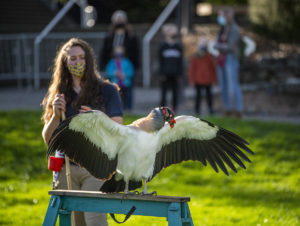
Next up this morning is Clark the vulture. He’s due for a nail trim, and again, Jessie’s prepared to let it happen on his terms.
“In the wild, vultures would eat big carcasses, using their feet to brace while they ripped with their beaks,” she explains, as she walks past the other Wild Wonders birds. “That would wear down their nails. Here, the food pieces are smaller, so we have to do it for him.”
Slowly, Jessie eases into Clark’s bedroom area. Up close he’s massive, with wide wings covered in thick dark feathers.
“Hi buddy!” says Jessie, stretching out a hand. Clark allows her to stroke his head, and with her other hand she pulls out the clippers, angling them toward one nail.
Clark isn’t having it. Letting out a hiss, he spreads his wings and shifts his feet. Jesse tries again, slowly and calmly: “Easy, boy.”
The vulture hisses and nips, just a little. Jessie smiles.
“Okay, not today then,” she agrees, and heads to the kitchen to wash her finger and put on a small Bandaid. Herald the dog looks up, interested at the change in routine. “It’s funny, 99% of my injuries are self-inflicted – usually in my kitchen at home – but people are always asking me if it happened at the Zoo! But it’s part of the job, though a small one.”
11:15am
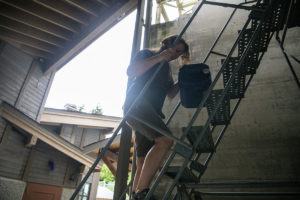
Jessie answers a radio call for Wild Wonders, passes it to a colleague and moves down the hallway to her final training partners for the morning: Mona Lisa and Celine, giant African pouched rats. Also called HeroRATs by the nonprofit in Africa that trains the species to detect landmines, pouched rats are larger than normal rats and extremely smart. These two are ambassadors for the program and are working on their first stage role at Wild Wonders – running across three swinging bridges high up on the stage. It’s not a difficult action for the rats, but for the keepers it has taken a little ingenuity – and some climbing themselves.
“Okay, here we go!” says Jessie.
She and fellow keeper Erica each scoop up a rat, pop them gently into a travel crate and start to climb a 12-foot metal ladder backstage. Up on a hidden platform, they set Mona and Celine onto the ramp leading to the ladders, then climb back down to front of house. On the way they pick up long poles of bamboo (grown in the Zoo gardens) with holes at each end. The keepers fill them with peanut butter – a treat most animals love.
“It’s veterinarian-approved, of course, but it’s high-fat and high-protein, and most of us love those kinds of treats,” Jessie explains.
“And this is a new behavior for them – it’s only their third time. So we want to make it really inviting! After all, you want to train for brownies, not broccoli, so to speak.”
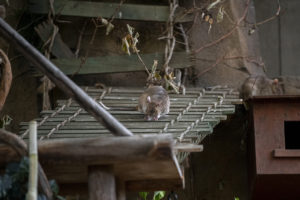
She holds up her pole halfway along the ramp. Both rats sniff, then Celine approaches and discovers Jessie’s pole.
“Good girl!” calls Jessie, clicking a training clicker as Celine licks eagerly.
Jessie flips her pole over and moves to the end of the ramp to tempt Celine, who follows.
“Yeah! That’s the girl!” calls Jessie.
Mona, meanwhile, is taking awhile to figure it out. Erica stands patiently, wiggling the end of her pole. As Jessie points out, positive reinforcement means just that: if you do the thing asked for, you get a reward. If you don’t, there’s no punishment – just no reward.
Eventually, both rats have scampered along two of the bridges, with plenty of peanut butter rewards, and both keepers are cheering them on.
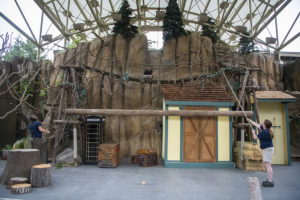
“Yes, girl! That’s it, yay!”
Then the rats decide they’re finished and head back – a good session.
“That’s the furthest they’ve ever been,” says Jessie, climbing up the ladder to retrieve them.
11:30am
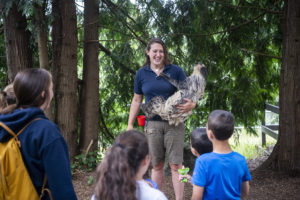
Glancing at the calendar as she passes – she’s listed on the 12pm training demo show – Jessie heads down to her last animal of the morning. It’s Siesta the sloth, a crowd favorite, who is going out to meet his fans in a Close Encounter. Handing Siesta a treat, Jessie reaches out her arms and Siesta reaches back, winding four limbs around the keeper as if she were a tree. He leans back and half-shuts his eyes, and Jessie sets off up the path.
Just by the penguins there’s a group of guests, who spot Siesta and exclaim delightedly.
“This is Siesta, he’s a two-toed sloth and he’s 20 years old,” introduces Jessie, feeding Siesta a grape. “Life for a sloth is like living at a B&B – lots of eating and sleeping.”
She chats with guests for about ten minutes, explaining everything from sloth eyesight (it’s bad) to fur color (it would be green with algae in the rainforest, for camouflage) to why Siesta isn’t a pet (please don’t try to pick up a sloth in the Amazon).
Then she takes Siesta back for another siesta, and heads onto the stage.
1:30pm
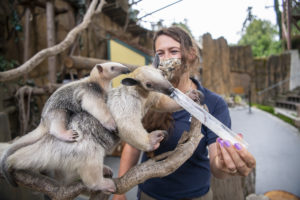
After lunch (for herself and animals) there’s more training, plus a good long walk around the Zoo to give Herald some exercise and people-greeting.
There’s another training demo or two, and a final feed close to 4:30pm.
Some days are different, including veterinary procedures at the Zoo’s animal hospital or staying after-hours to bring an ambassador animal like Siesta to Zoo events. The job includes weekends – Jessie works Sundays to Thursdays – and holidays.
And when there’s a baby animal in the house, like recently-born tamandua pup Liana, keepers often stay overnight for round-the-clock feeding and monitoring, sleeping on a couch with the dog.
But for Jessie and the other keepers, it’s worth it.
“I love training, and it brings me a lot of joy to make sure our animals’ lives are full, happy and healthy,” she says. “But my favorite part about being a zookeeper is sharing those animals with people. I really hope it inspires their passion for animals and our natural world.”
